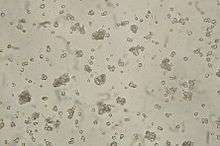Starch analysis

Starch analysis or starch grain analysis is a technique that is useful in archaeological research to determine plant taxa. In certain samples of food plants, spices, drugs and desiccated archaeological plant matter, the histological elements can survive and thus be identified but in other samples, like carbonized (burnt) or older materials this is extremely difficult. However starch grains are much more hardy. The technique relies on the fact that a researcher can analyze or microscopically observe starch grains found on artifacts or in soils. Starch grains, ubiquitous in plants, have individual characteristics and resistance to grinding and drying and even to light burning so they are often preserved when other plant remains are lost - thus providing an additional tool to understand the past use of plants.
Usefulness
Starch grain analysis is not a perfect science, however, plant starch grain analysis is a diagnostic feature of multiple applications according to the peculiarities and to the origin of the plant material.[1] The size, shape and structure of grains from plant species, varies little, which can lead to identification. Starch grains have been removed and identified from stone tools, ceramic sherds, organic materials, dental calculus, and sediments[2] and animal remains to determine diet and when humans began to exploit wild food varieties.[3]
Disadvantages
In some cases the grains can become degraded. Factors such as heat and water absorption may affect the structure of the grains, making identification more difficult. Even if the remains are well preserved, water logging, dehydration, desiccation or damage from fungi can destroy the starch. In some cases, even within the same species, starch grains can differ in shape and size and the size of the grain affects its survivability in the archaeological record (Haslam 2004).
Biology of starch
Starch is produced in plants as a form of energy storage through the process of photosynthesis. When the plant is in need of energy, the stored starch is converted back into glucose.[4]
Starch grain identification
There are two basic methods for identifying starch:
- Diagnostic tests of chemical and physical properties
- Optical properties of the granules.

Starch grains are typically microscopically identified with either optical or electron microscopy. Starch grains can become clearer if they are stained a darker color with Iodine Stains. Logol's Iodine is one, used for staining starch because iodine reagents easily bind to starch but less easily to other materials. Features that allow identification of starch grains include: presence of hilum (core of the grain), lamellae (or growth layers), birefringence, and extinction cross (a cross shape, visible on grains under revolving polarized light) which are visible with a microscope and shape and size.[2]
Low magnification
Archaeological research focused on residue adhering to artifacts start at lower magnifications, commonly using a stereoscope. Most data obtained at this stage is qualitative, an important first stage to fuller analysis. Magnifications of between x10 and x50 are sufficient to locate target residues, describe features and confirm internal structures of the identified residues.[5]
High magnification
Modern light, high powered microscopes have an internal light source, allowing illuminaton with both transmitted and reflected light. These microscopes can provide a magnification of up to x1000: good enough to provide clear images of starch granules as small as a few micrometres in diameter.[6]
Starch granules show different sizes. For example;
- Tapioca starch: 5-35 µm
- Potato starch: 15-100 µm
- Maize starch: 5-25 µm
- Rice starch: 3-8 µm
but all are generally under 100 micrometres in size, and are, therefore, best observed under compound microscopes equipped with various lighting conditions and magnifications from x200 to x800.[7]
The starch grains are also compared to standard reference collections for comparison. Archaeologists and researchers can consider four issues in classification of the plant(s) and its use(s):
- Determination of whether evidence for the utilization of plants is present
- Study of the assemblage variation
- Determination of the presence of particular plant species
- Assign percentages of starch granules within a sample to a particular taxon, and present quantitative data regarding relative abundance within the sample. Identification of ancient starch is fairly easily for the first three levels of classification, whilst the fourth level requires continued improvement in the description, classification, and identification of individual starch granules.[8]
Starch in sediments
Starch granules retrieved from sediments are used to reconstruct the habitats associated with human land use. Such studies address two areas of interest to the archaeologist:
- landscapes; specifically the reconstruction of historical plant communities at the widest scale of the environment
- specific contexts, such as settlements or activity areas; focusing on individual archaeological sites, or separate contexts within them, with the goal of identify specific human activities at a particular location.
The stages involved in the analysis of starch from sediments are; sampling, extraction of starch, slide mounting and viewing, and interpretation.[9]
Sampling
Sampling a sediment core or stratigraphic profile to gather information about an environment requires a detailed understanding of the way the sediments were formed.[10]
Extraction
Most extraction techniques follow a general methodology of:
- sample preparation (sieving, drying, or soaking)
- disaggregation and deflocculation to break up the elements of the sample into single particles
- removal of undesired particles (sands, silts, minerals, organics).
- chemicals preservation of the starch granules.[11]
Slide mounting and viewing
Starch granules are mounted onto a slide, using a variety of mounting medias including, but not limited, to water, glycerol, and glycerine jelly. It is important that the material is dried thoroughly before being mounted to ensure that no further degradation of the sample occurs. The slide is then viewed, as appropriate, for identification and counting.[12]
Interpretation
After the starch granules have been examined, the findings are then recorded and interpreted with respect to the research questions that are being investigated.
Starch on artifacts
Artifacts collect starch granules and protect them from decay due to microorganisms, thus providing excellent conditions for long-term preservation. The analysis may focus on the function of the tool, to examine a broader range of human behaviour but starch analysis also allows insights into craft activities involving the preparation of adhesives, medicines, or other nonfood items.[13]
Modified starch
Starch can also be investigated when it is not in its raw form. For example, Modified starch is created when the morphological or physico-chemical structure of native starch is disrupted in some way, such as in food preparation. The most common way to modify starch is to apply heat. Cooking pits, hearths, and ovens that may have come into contact with starchy material yield modified starches which can provide other insights.
Modified starch is only likely to be preserved under specific conditions, such as arid regions because of its susceptibility to organic decay. Studies of ancient modified starch aid understanding of ancient food technology, variations in cuisine among different social groups, as well as provide an understanding the function of ancient food-processing equipment.[14]
Preserved forms of modified starch include:
- discrete desiccated macroremains: coherent foods that are not attached to any other object and are among the most easily recognizable ancient starchy prepared foodstuffs. They can be either the intended final prepared food, like loaves of bread, or intermediate products of the food processing sequence, like starch-rich, chaffy lumps.
- attached desiccated residues: collections of starchy foodstuffs adhered to a container or vessel. The ability to identify these residues is affected by the quantity and appearance of the residue, as well as the awareness of the excavators. Residues containing obvious plant tissue are most easily recognizable, while thin smears are not as easy to recognize.
- charred residues: normally the result of accidental overcooking and can be preserved as discrete fragments or remain stuck to the cooking vessel. Due to their charred nature, these residues are very difficult to identify.[15]
See also
Field, J. Cosgrove, R. Fullager, R. & Lance, B. (2011) "Starch residues on grinding stones in private collections: a study of morahs from the tropical rainforests of NE Queensland" in Haslam, M. Robertson, G. Crowther, A. Nugent, S. & Kirkwood,L.(Eds) Archaeological Science Under a Microscope (Terra Australis 30) Studies in Residue and Ancient DNA Analysis in Honour of Thomas H. Loy. ANU E Press. Canberra. 228-238
Hather, J.G. (ed.) 1994. Tropical Archaeobotany: Applications and New Developments, pp. 86-114. Routledge, London.
Messner, Timothy C. 2011. Acorns and Bitter Roots: Starch Grain Research in the Prehistoric Eastern Woodlands. University of Alabama Press, Tuscaloosa, AL.
Torrence, Robin, and Huw Barton, editors. 2006. Ancient Starch Research. Left Coast Press, Walnut Creek, CA.
References
- ↑ Cortella, A. R.; Pochettino, M. L. (1994). "Starch grain analysis as a Microscopic Diagnostic Feature in the Identification of Plant Material". Economic Botany. 48 (2): 171–181. doi:10.1007/BF02908212. ISSN 0013-0001.
- 1 2 Clarissa Cagnato. "Starch Grain Analysis - Paleoethnobotany". Retrieved 2014-06-25.
- ↑ Nature 430, 670-673 (5 August 2004) | doi:10.1038/nature02734; Received 4 May 2004; Accepted 4 June 2004
- ↑ Torrence 2006, p. 35,36
- ↑ Torrence 2006, p. 47,48
- ↑ Torrence 2006, p. 48,49
- ↑ Torrence 2006, p. 47
- ↑ Torrence 2006, pp. 115–143
- ↑ Torrence 2006, p. 145
- ↑ Torrence 2006, pp. 145–151
- ↑ Torrence 2006, pp. 151–161
- ↑ Torrence 2006, pp. 161–163
- ↑ Torrence 2006, pp. 185–189
- ↑ Torrence 2006, p. 205
- ↑ Torrence 2006, pp. 206–207
Torrence, Robin (2006), Ancient Starch Research, Walnut Creek, CA: Left Coast Press Inc., ISBN 1-59874-018-0